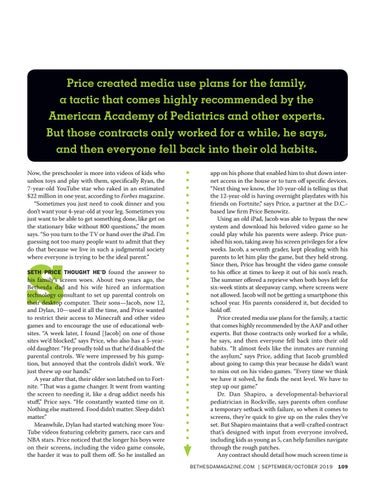Price created media use plans for the family, a tactic that comes highly recommended by the American Academy of Pediatrics and other experts. But those contracts only worked for a while, he says, and then everyone fell back into their old habits. Now, the preschooler is more into videos of kids who unbox toys and play with them, specifically Ryan, the 7-year-old YouTube star who raked in an estimated $22 million in one year, according to Forbes magazine. “Sometimes you just need to cook dinner and you don’t want your 4-year-old at your leg. Sometimes you just want to be able to get something done, like get on the stationary bike without 800 questions,” the mom says. “So you turn to the TV or hand over the iPad. I’m guessing not too many people want to admit that they do that because we live in such a judgmental society where everyone is trying to be the ideal parent.”
S
SETH PRICE THOUGHT HE’D found the answer to
his family’s screen woes. About two years ago, the Bethesda dad and his wife hired an information technology consultant to set up parental controls on their desktop computer. Their sons—Jacob, now 12, and Dylan, 10—used it all the time, and Price wanted to restrict their access to Minecraft and other video games and to encourage the use of educational websites. “A week later, I found [Jacob] on one of those sites we’d blocked,” says Price, who also has a 5-yearold daughter. “He proudly told us that he’d disabled the parental controls. We were impressed by his gumption, but annoyed that the controls didn’t work. We just threw up our hands.” A year after that, their older son latched on to Fortnite. “That was a game changer. It went from wanting the screen to needing it, like a drug addict needs his stuff,” Price says. “He constantly wanted time on it. Nothing else mattered. Food didn’t matter. Sleep didn’t matter.” Meanwhile, Dylan had started watching more YouTube videos featuring celebrity gamers, race cars and NBA stars. Price noticed that the longer his boys were on their screens, including the video game console, the harder it was to pull them off. So he installed an
app on his phone that enabled him to shut down internet access in the house or to turn off specific devices. “Next thing we know, the 10-year-old is telling us that the 12-year-old is having overnight playdates with his friends on Fortnite,” says Price, a partner at the D.C.based law firm Price Benowitz. Using an old iPad, Jacob was able to bypass the new system and download his beloved video game so he could play while his parents were asleep. Price punished his son, taking away his screen privileges for a few weeks. Jacob, a seventh grader, kept pleading with his parents to let him play the game, but they held strong. Since then, Price has brought the video game console to his office at times to keep it out of his son’s reach. The summer offered a reprieve when both boys left for six-week stints at sleepaway camp, where screens were not allowed. Jacob will not be getting a smartphone this school year. His parents considered it, but decided to hold off. Price created media use plans for the family, a tactic that comes highly recommended by the AAP and other experts. But those contracts only worked for a while, he says, and then everyone fell back into their old habits. “It almost feels like the inmates are running the asylum,” says Price, adding that Jacob grumbled about going to camp this year because he didn’t want to miss out on his video games. “Every time we think we have it solved, he finds the next level. We have to step up our game.” Dr. Dan Shapiro, a developmental-behavioral pediatrician in Rockville, says parents often confuse a temporary setback with failure, so when it comes to screens, they’re quick to give up on the rules they’ve set. But Shapiro maintains that a well-crafted contract that’s designed with input from everyone involved, including kids as young as 5, can help families navigate through the rough patches. Any contract should detail how much screen time is BETHESDAMAGAZINE.COM | SEPTEMBER/OCTOBER 2019
109
